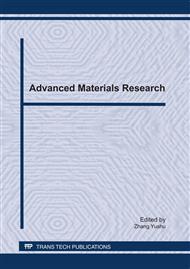[1]
Wang YL, Cai SZ: Biomechanics and bone tissue engineering. Advances in Mechanics, Vol. 29(2) (1999), p.232.
Google Scholar
[2]
Hutmacher D.W.: Scaffolds in tissue engineering bone and cartilage. Biomaterials, Vol. 21 (2000), p.2529.
DOI: 10.1016/s0142-9612(00)00121-6
Google Scholar
[3]
Ye JZ, Zhang CQ, Men YT, etal: The research of numerical simulation method on bone injury, healing and stress shielding. Proceedings of Tianjin Society of Biochemical Engineering Annual Meeting (2007), p.60.
Google Scholar
[4]
Sandino C, Planel J.A., Lacroix D: A finite element study of mechanical stimuli in scaffolds for bone tissue engineering. Journal of Biomechanics, 41(5) (2008), p.1005.
DOI: 10.1016/j.jbiomech.2007.12.011
Google Scholar
[5]
Byrne D.P., Lacroix D, Planell J.A., etal: Simulation of tissue differentiation in a scaffold as a function of porosity, Young's modulus and dissolution rate: Application of mechanobiological models in tissue engineering. Biomaterials, 28 (2007).
DOI: 10.1016/j.biomaterials.2007.09.003
Google Scholar
[6]
Porter N.L., Pilliar R.M., Grynpas M.D.: Fabrication of porous calcium polyphosphate implants by solid freeform fabrication: A study of processing parameters and in vitro degradation characteristics. Journal of Biomedical Materials Research, 56(4) (2001).
DOI: 10.1002/1097-4636(20010915)56:4<504::aid-jbm1122>3.0.co;2-j
Google Scholar
[7]
Bai XF, Zhu D, Zhang CQ: Structural simulation of proximal femur. Natural Science Journal of Jilin University of Technology, 30(4) (2000), p.56.
Google Scholar
[8]
Gao YL: Simulation analysis of stress in bone and implanted hydroxyapatite using finite element method (Master). Tianjin. Tianjin University (2005): 53-62.
Google Scholar
[9]
Ke H, Ning CQ, Jia DC, etal: Development of hydroxyapatite and titanium as bone substitute materials. NONFERROUS METALS, 53(4) (2001) p.8.
Google Scholar
[10]
Yao J, Turteltaub S.R., Ducheyne P: A three-dimensional nonlinear finite element analysis of the mechanical behavior of tissue engineered intervertebral discs under complex loads. Biomaterials, 27(3) (2006) p.377.
DOI: 10.1016/j.biomaterials.2005.06.036
Google Scholar
[11]
Wolff J.L.: The law of hone remodeling (Trans Springer, Berlin 1892).
Google Scholar


